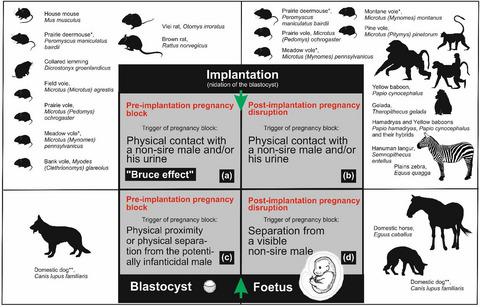当前位置:
X-MOL 学术
›
Mammal Rev.
›
论文详情
Our official English website, www.x-mol.net, welcomes your feedback! (Note: you will need to create a separate account there.)
How to escape male infanticide: mechanisms for avoiding or terminating pregnancy in mammals
Mammal Review ( IF 4.9 ) Pub Date : 2020-08-18 , DOI: 10.1111/mam.12219 Luděk Bartoš 1, 2 , Adam Dušek 1 , Jitka Bartošová 1, 2 , Jan Pluháček 1 , Rory Putman 3
Mammal Review ( IF 4.9 ) Pub Date : 2020-08-18 , DOI: 10.1111/mam.12219 Luděk Bartoš 1, 2 , Adam Dušek 1 , Jitka Bartošová 1, 2 , Jan Pluháček 1 , Rory Putman 3
Affiliation

|
The phenomenon whereby pregnancy may be inhibited or terminated when a female is exposed to non‐sire males after mating is often, and rather generally, referred to as the ‘Bruce effect’. Widespread and indiscriminate use of the term for any case of pregnancy failure following exposure to an unfamiliar male, however, masks distinct physiological and social causes of the blocking or termination of pregnancy. Within the available literature, we identify four basic processes by which mammalian females can terminate pregnancy, and thus minimise risks of wasted reproductive costs which might result from male infanticide by a subsequent consort of any progeny carried to full‐term where he was not the father. Physical contact with a non‐sire male may induce pregnancy failure either before implantation (pregnancy block) or after implantation (pregnancy disruption). By direct contrast, in other species, physical presence of a familiar non‐sire male may act to prevent the blocking or disruption of pregnancy, while separation from this non‐sire male may act to trigger termination. We propose that use of the term ‘Bruce effect’ should be restricted to situations in which pregnancy failure is induced primarily by physical contact and/or odour stimuli from a non‐sire male as in its initial formulation. Blanket use of this single term for all situations of pregnancy block or disruption, implying by default that pregnancy failure is the consequence of pre‐implantation pregnancy block of an inseminated female as a result of physical contact with an unfamiliar male or his olfactory cues, masks the fact that, in many circumstances or species, very different mechanisms may operate in the prevention or disruption of pregnancy. The implicit presumption that pregnancy failure is a single and uniform phenomenon also discourages further research into the range of rather different circumstances and mechanisms by which pregnancy disruption may be triggered.
中文翻译:

如何逃脱杀男婴:避免或终止哺乳动物怀孕的机制
当女性在交配后暴露于非父系的雄性时,可能会抑制或终止妊娠的现象通常被称为“布鲁斯效应”。该术语在接触陌生男性后出现妊娠失败的任何情况中得到广泛使用,但掩盖了阻止或终止妊娠的独特生理和社会原因。在现有文献中,我们确定了哺乳动物雌性可以终止妊娠的四个基本过程,从而最大程度地降低了由于雄性杀婴而导致的繁殖成本浪费的风险,而后者可能是由后代将其子代带到足月(如果他不是父亲) 。与非父亲的男性进行身体接触可能会在植入前(妊娠受阻)或植入后(妊娠受孕)导致妊娠失败。与之形成直接对比的是,在其他物种中,熟悉的非父系雄性的物理存在可能会阻止怀孕的受阻或中断,而与该非父系雄性的分离可能会触发终止。我们建议使用“布鲁斯效应”一词应仅限于这样的情况,即妊娠失败主要是由于非雄性男性的身体接触和/或气味刺激引起的,如其最初的配方一样。禁止在怀孕受阻或中断的所有情况下使用该术语,默认情况下暗示怀孕失败是受孕女性与陌生男性或其嗅觉的身体接触导致的植入前妊娠受阻的结果,掩盖了以下事实:在许多情况或物种中,作用机制可能完全不同预防或破坏怀孕 怀孕失败是一个单一且统一的现象的隐含推论也不利于进一步研究可能触发怀孕中断的各种不同情况和机制。
更新日期:2020-08-18
中文翻译:

如何逃脱杀男婴:避免或终止哺乳动物怀孕的机制
当女性在交配后暴露于非父系的雄性时,可能会抑制或终止妊娠的现象通常被称为“布鲁斯效应”。该术语在接触陌生男性后出现妊娠失败的任何情况中得到广泛使用,但掩盖了阻止或终止妊娠的独特生理和社会原因。在现有文献中,我们确定了哺乳动物雌性可以终止妊娠的四个基本过程,从而最大程度地降低了由于雄性杀婴而导致的繁殖成本浪费的风险,而后者可能是由后代将其子代带到足月(如果他不是父亲) 。与非父亲的男性进行身体接触可能会在植入前(妊娠受阻)或植入后(妊娠受孕)导致妊娠失败。与之形成直接对比的是,在其他物种中,熟悉的非父系雄性的物理存在可能会阻止怀孕的受阻或中断,而与该非父系雄性的分离可能会触发终止。我们建议使用“布鲁斯效应”一词应仅限于这样的情况,即妊娠失败主要是由于非雄性男性的身体接触和/或气味刺激引起的,如其最初的配方一样。禁止在怀孕受阻或中断的所有情况下使用该术语,默认情况下暗示怀孕失败是受孕女性与陌生男性或其嗅觉的身体接触导致的植入前妊娠受阻的结果,掩盖了以下事实:在许多情况或物种中,作用机制可能完全不同预防或破坏怀孕 怀孕失败是一个单一且统一的现象的隐含推论也不利于进一步研究可能触发怀孕中断的各种不同情况和机制。



























 京公网安备 11010802027423号
京公网安备 11010802027423号